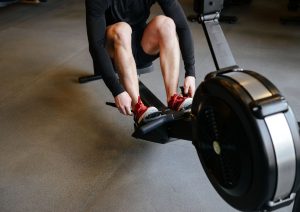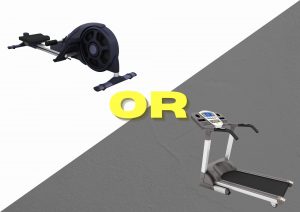Among fitness buffs, the rowing machine is considered to be one of the most effective since it provides a low-impact, full-body workout. Many are using rowers for core strength and these are investments they are willing to make.
But how does a rowing machine build core strength? Let’s dig into the awesomeness of this innovation.
Why Rowing Machines Increase Core Strength
The rowing machine works the body hard and if used the right way, it engages the core significantly, thus reinforcing the muscles in that area. Rowing involves not only the calves, quadriceps and glutes, it also engages your abdominals, arms, pecs and obliques.
As explained by the American Fitness Professionals Association, the rowing strokes done using the device are comprised of 65 to 75% leg work while the remaining 25 to 35% work the upper body.
The equipment needs lots of strength from the upper body and abdominal muscles with every stroke, thus forcing those parts to exert plenty of effort. And with all that extra effort, strength develops.
The rowing machine has made a profound impact in the fitness community when it was introduced, and the positive response to the device is unwavering. If you are a beginner, it’s time to get to know the device more and use it correctly for the best results.
First, Get Familiar With Rowing Terms And Methods

The rowing machine not only strengthens muscles in your abs, they also improve endurance and stamina. Plus, it’s virtually simple to use with instructions. There’s no steep learning curve involved; it won’t take long for beginners to get the hang of the device.
To kick off correct rowing machine use, know the methods first.
1. Rowing Stroke
The stroke’s work portion is referred to as the drive while recovery refers to its rest portion. Recovery preps up users for the subsequent drive. Furthermore, the recovery’s motions are the drive’s reverse. To do the rowing stroke, you need to combine those movements together.
2. Catch
To do the catch, you must make sure your arms are straight and the head is neutral. Do not hunch your shoulders. Your upper body should lean forward from the hips along with the shoulders in front of it. The shins must be vertical and the heels may be lifted if need be.
3. Drive
Do the drive by pressing the legs first. Swing the back by means of the vertical position before doing the arm pull. Make sure that the hands move in line to and from the device’s flywheel. See to it that your shoulders are kept relaxed and low throughout this rowing technique.
4. Finish
To do this, let your upper body lean back a little with some help from the muscles of your core. Extend the legs and hold the handle lightly under your ribs. Keep the shoulders low. Make sure that your grip and wrists are kept relaxed. Furthermore, your wrists must be kept flat as well.
5. Recovery
Get into the recovery rowing method by extending the arms until they are straightened. Lean from the hips to the direction of the flywheel. As soon as your hands unblocked the knees, let the knees bend. Slide the seat forward bit by bit on the monorail.
To do the subsequent stroke, go back to the catch position. Relax the shoulders and keep the shins vertical.
The rowing machine in general makes for a workout that is safe for everyone. However, before you activate abdominal muscles using the rowing machine, check with your physician if you have had a previous injury or experienced lower back pain.
Rowing Machine Don’ts To Remember
When using the rowing machine, you have to be in proper form. Proper form is crucial for all types of workouts and rower routines are no exception. Otherwise, you might be uncomfortable throughout, won’t get the results you are after, or worse, get injured. Avoid the following blunders for a successful, stress and discomfort-free workout.
1. Ignoring The Use Of Your Core Muscles
Proper use of a rowing machine for results involves the use of your core muscles. Before pushing back using your legs, ensure that you have engaged your core. Or else, you will be going through the motions using your hips rather than the legs.
2. Relying On Arms Alone
Using a rower for core strength should involve not only your arms but the other muscles as well. Actually, the device’s design is targeted around the leg area – this means roughly 60% of the labour must involve the legs. Push using your legs accompanied by a little backwards hip hinge. Pull by using the arms while keeping your core involved.
3. Hunching During The Workout
Rounding or hunching the back over the course of the workout will put a lot of strain on those parts. Be sure to sit straight and hold this position during rowing machine use.
4. Starting With Arms And Upper Body
Correct technique is essential in good rowing machine usage. Do not begin the workout using the arms and the upper body. Always start the routine with a push using the legs and feet. Next, you have to hinge backwards at the hips – see to it that the shoulders pass the pelvis bone until you return the arms to the chest.
The hands should not go beyond the sternum. Reverse that order, go back to the starting position and repeat the procedure.
5. Using The Wrong Damper Setting
Beginners should always start with a damper setting that suits them. The most ideal setting for all would have to range between 3 to 5. You can also try out a couple of levels higher and test the setting if it’s doable for you.
Once your muscles get attuned to the rowing machine, you can finally increase the setting of the damper. Always listen to your body to make rowing machines use easier and stress-free.
6. Speeding Up The Routine
Workouts should never be rushed. Do not get too excited to see results. Always work out at a steady pace – mind the rhythm to guarantee that all muscles engaged during rower use will get the maximum range of motion. Being in proper form, controlling the speed and using full strokes at a slower pace will eventually bring you the results you need.
Rower Workout Sample
The beauty of the rower is that you can create your own routines with it. A successful rowing machine workout is something suitable for your level and done in proper form. For beginners looking for a simple workout, we’ve got this one for you – this routine is short, has moderate intensity and allows users to fully concentrate on their form.
Rower newbies can begin with approximately 10 minutes of exercise. Add more time every week once your body gets familiarised with the workings of the machine.
- Warm-up at a relaxed pace for 5 minutes by utilising effortless, periodic strokes – this is to increase your heart rate. Exertion rate must be 3 to 4.
- Increase the strokes per minute for moderate rower intensity. Exertion rate at this point must read 5 to 6. Reach 300 meters using this pace.
- For the 2-minute recovery phase, decelerate and take a breather by decreasing the strokes per minute. You can use the legs to course to and fro to recover or just simply rest for a little.
- Go back to 300 meters using moderate pacing. Do this by increasing the strokes per minute.
- Take 2 minutes to recover by slowing down.
- For the last part of this workout, increase the strokes per minute and make sure it reaches an exertion rate of 7.
- Cool down for 5 minutes. Finish the routine by performing stretches.
Conclusion
Keep your body strong and toned by taking advantage of this device’s functions. Create a regular routine to activate abdominal muscles using the rowing machine. By utilising it correctly, your core gets reinforced, your posture improves, and all other muscles engaged during the workout will surely look amazing.
Related Questions

1. Should you keep your back straight when rowing?
You must keep track of your posture when using the rowing machine. Sit up straight, keep your chest up and let those shoulders relax. Doing so will prevent putting too much strain on the back.
2. Which one is better for core strength, treadmill or rowing machine?
If you are after strengthening your core, you should use a rowing machine instead of the treadmill. The rower provides a full-body workout which means it engages a nice range of muscle groups in the arms down to the core. Rowers make for a high-intensity workout, too but with less impact so it’s gentler on the joints.
3. Does rowing tone your arms?
Rowing gives a complete body workout so this means it reinforces key muscle groups in the legs, the core and the arms. You can also supplement your rower routines with push-ups to further tone the arms.